Choosing an Efficient Water Heater
Heat-pump water heaters offer the most energy savings, but they still struggle for a toehold in the market.

Synopsis: When it comes to purchasing a new water heater, most buying decisions are made quickly and under duress, which means efficiency falls by the wayside. This article gives a rundown of different types of energy-efficient water heaters—tankless electric and gas models, electric heat-pump units, and condensing gas models—and explains how their efficiency is measured, and which units make the most sense to purchase depending on the fuel source.
A long-running ad campaign for Maytag featured an affable but underworked repairman who spent his days snoozing in an office chair because the appliances he sold rarely needed any attention. “I’m the loneliest guy in town,” he complained with a sigh.
The story line may ring a bell with John Miles, who heads Eco Systems, Sanden International’s heat-pump water heater operation in the U.S. Although the products he represents are among the most efficient water heaters on the market, Miles is still waiting for that breakthrough year when consumers and HVAC specialists finally wake up to the unique advantages heat-pump water heaters offer.
They are head and shoulders above anything else that’s available, but command just a little over 1% of the market—of the more than 8 million residential water heaters sold in the U.S. last year, roughly 100,000 of them were heat-pump appliances, Miles said in a telephone call, and Sanden accounted for only a small percentage of that.
“It’s been a hard nut to crack,” said Miles.
Heat-pump water heaters are unfamiliar to many U.S. consumers despite widespread success in Japan and Europe. Like other types of air-source heat pumps, including appliances used for space heating, they extract residual heat from the air without burning any fuel directly. But they are just one option among many for residential water heating. Water heaters with integral storage tanks powered by either gas or electricity are the industry’s old standbys. Manufacturers have increased the energy efficiency of gas models with condensing burners that wring almost all of the potential heat from flue gases. There are also various on-demand tankless water heaters that don’t have the standby losses associated with storage tanks.
Homeowners may be focused on price and capacity, but efficiency counts. The U.S. Department of Energy (DOE) estimates that domestic hot water represents between 14% and 18% of total home-energy use, more than all other household appliances combined and second only to space heating. At an average of 64 gal. of hot water per day, U.S. households spend between $400 and $600 a year.
Chiseling away at those numbers can add up to big savings over time, but buying decisions are often made quickly and under duress. Miles estimates that more than 75% of all water heaters are sold on an emergency basis—that is, only when an existing water heater springs a leak or otherwise fails. Homeowners are likely to buy what the plumber has on the truck, not on the basis of what will produce hot water most efficiently. That’s too bad. A little homework would go a long way toward lowering energy costs.
Tankless Water Heaters
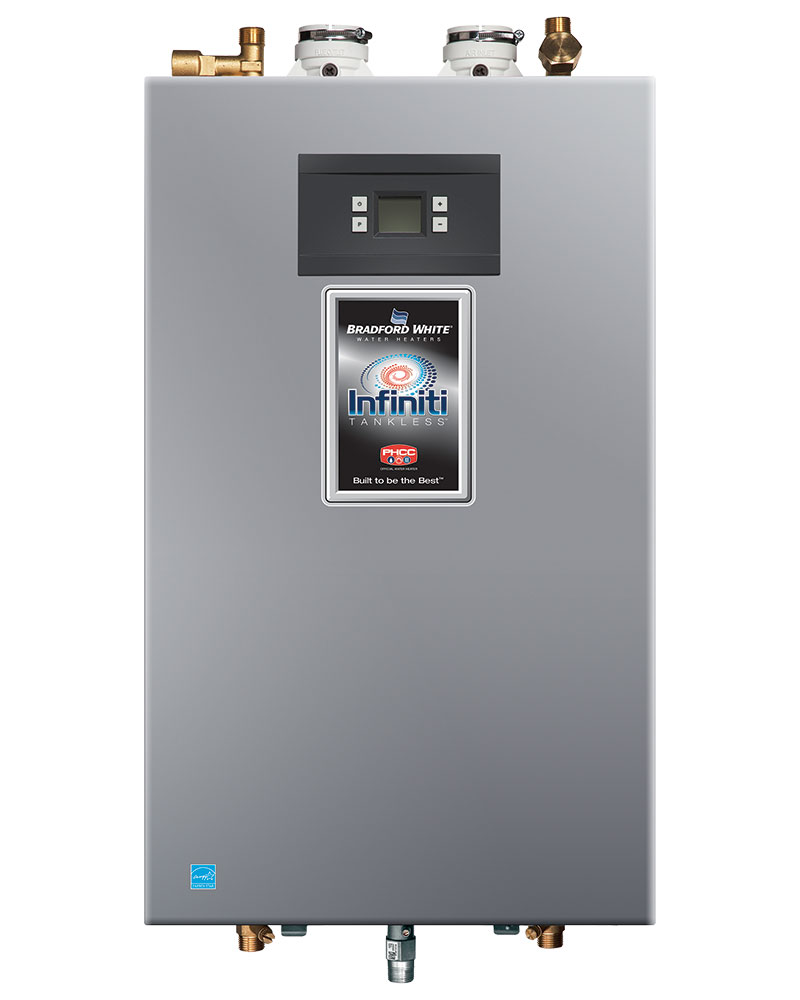 |
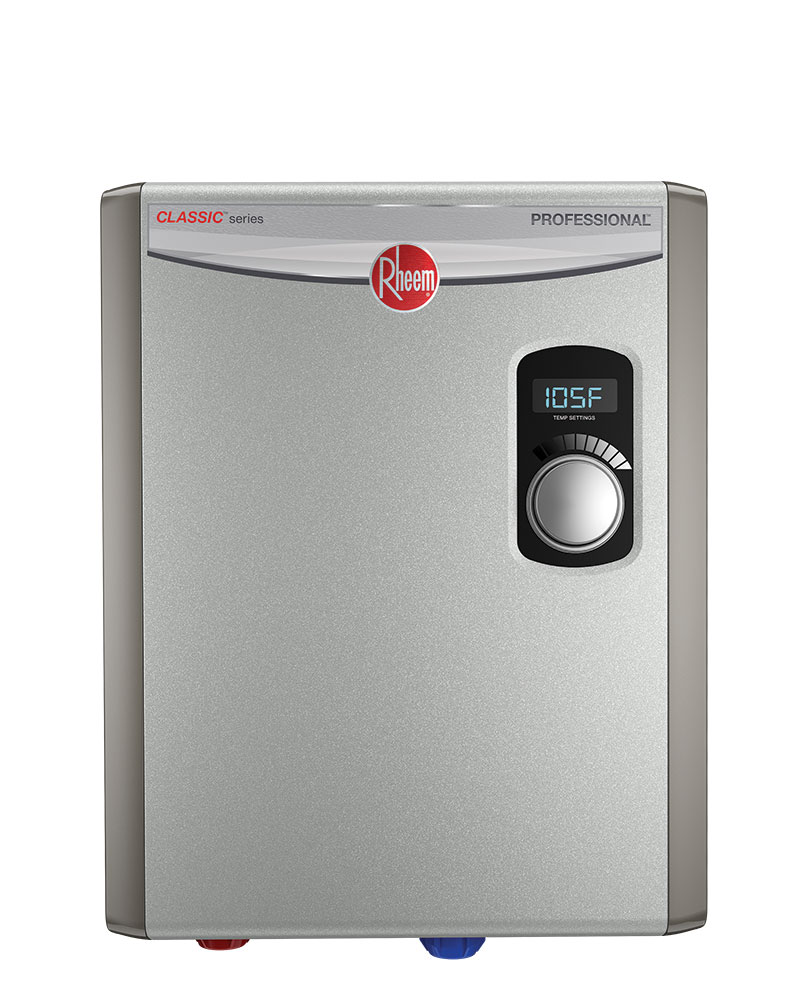 |
Often chosen for their compact size and endless stream of hot water, these so-called “on-demand” water heaters are most commonly fueled by gas (Bradford White Infiniti), but electric models are available (Rheem Professional Classic and Stiebel Eltron Tempra Plus). Because they heat water as it’s needed, hot-water production is measured in gallons per minute (gpm), and depends on the temperature of the water entering the heater. Comparing gpm ratings from one brand to another isn’t straightforward, as the temperatures used in these calculations often vary and don’t reflect actual usage.
How the government measures efficiency
When someone goes shopping for a new car, one factor to consider is how many miles the vehicle can travel on a gallon of gas. The DOE has developed a similar metric for water heaters called the Uniform Energy Factor (UEF). It’s based on standardized tests administered by the DOE and ranks performance numerically—the higher the UEF, the greater the energy efficiency. UEFs range from roughly 0.6 to 0.95 for gas and electric models and up to 3.7 for heat-pump water heaters.
The UEF does not appear on the EnergyGuide labels you may see on water heaters at your local big box store. That’s because, in the U.S., there are three separate agencies that work on this issue. According to Chris Granda of the Appliance Standards Awareness Project, the EPA runs the Energy Star program, the DOE sets minimum energy standards and administers UEF testing, and the Federal Trade Commission (FTC) is responsible for the labels consumers see in the store. “The reason why you don’t see the UEF on the energy label is because no one at the DOE, which is charged with coming up with the UEF and administering it, is talking with the FTC,” Granda said.
The FTC singles out two other numbers for the EnergyGuide labels: the estimated annual cost of hot water, and the amount of hot water the appliance will produce in the first hour of use (the first-hour rating, or FHR). You can find UEF ratings either from the manufacturers or in an online database maintained by the DOE.
There are other important caveats to UEFs. The ratings are based on four levels of hot water use—very small, low, medium, and high—and the DOE warns consumers not to compare the UEF in one usage category with a UEF for a different usage category. If you’re trying to track down the most efficient electric storage water heater in a single volume category, comparing the UEFs (if they are provided) will be useful. Not so much when comparing a “very small” hot-water household to a “medium” household, and certainly not when trying to choose between a gas-fired and an electric model.
Still, Granda says, the UEF is important because it’s a common metric that everyone can understand, and it can be reliably replicated.
Heat-Pump Water Heaters
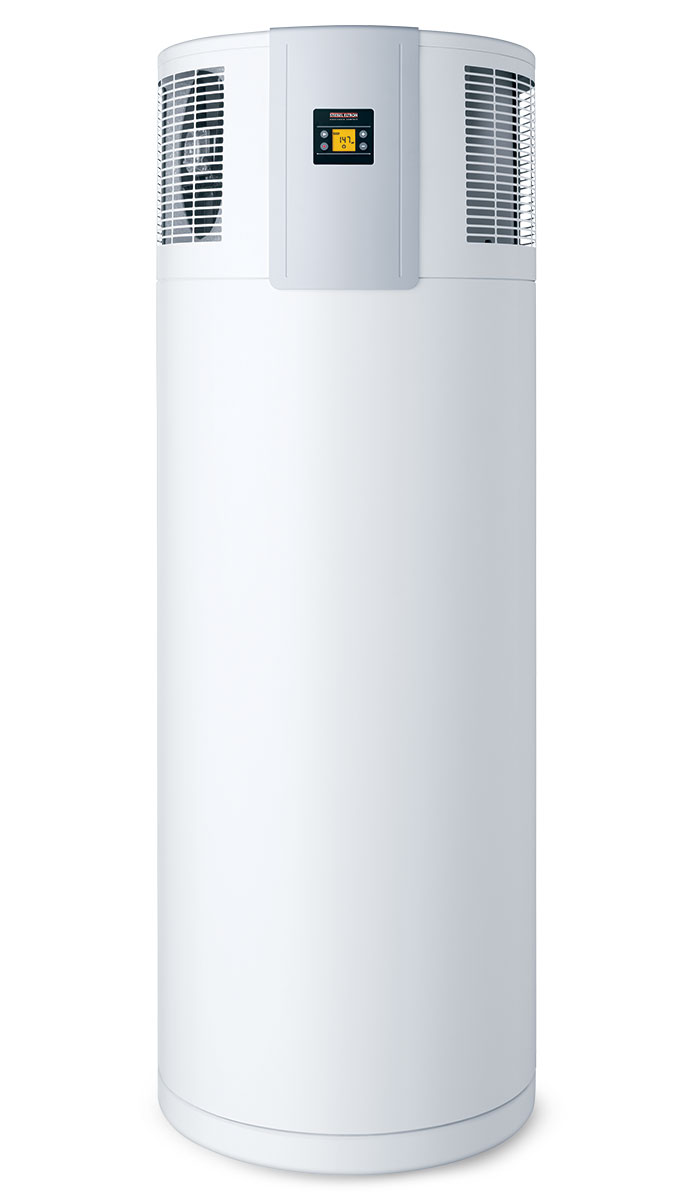 |
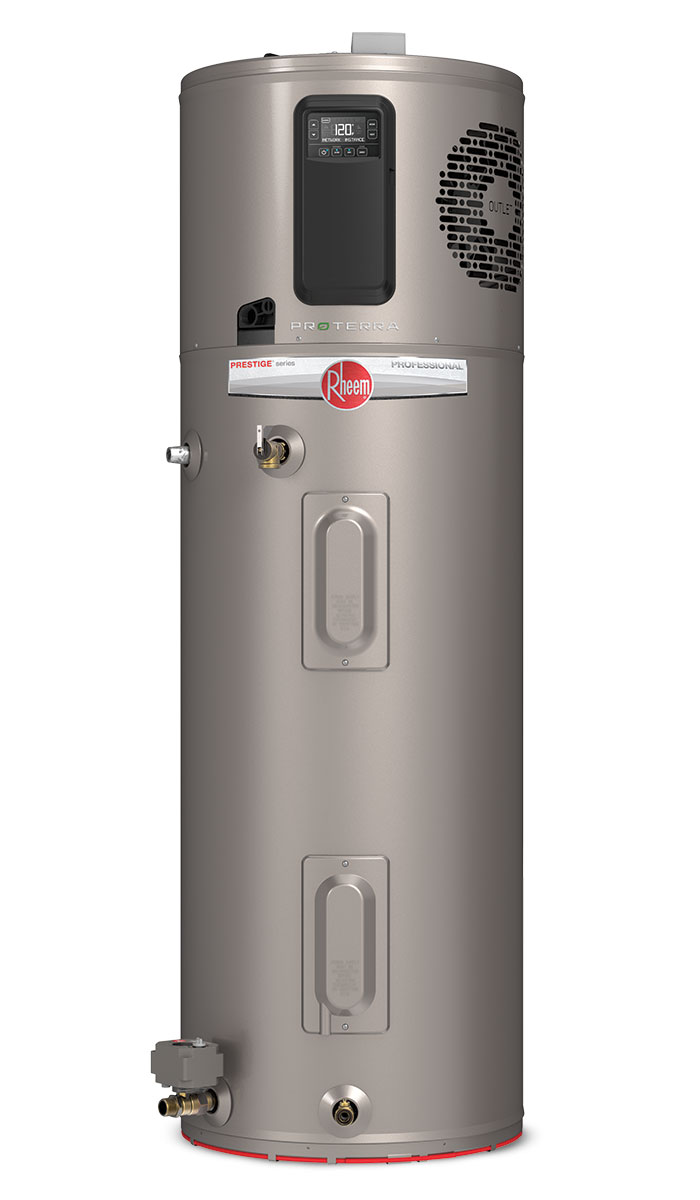 |
Most water heaters in this category combine heat pumps with conventional electric resistance coils that are activated when the heat pump can’t keep up with demand. (While they are very efficient, heat pumps do work slowly.) When comparing models, consider the first-hour rating, which is the number of gallons of hot water the heater can supply per hour (starting with a full tank of water).
| Most heat-pump water heaters combine the heat-pump compressor and tank in an integral unit. Sanden’s SanCO2 is unique in the U.S.—it’s a split system with the storage tank inside the house and a separate compressor outside. Even more unique is the fact that it uses CO2 as the refrigerant rather than a hydrofluorocarbon. |
If electricity is the fuel, go with a heat-pump unit
Although heat-pump water heaters cost more than those powered by electrical resistance heating coils, they are far more efficient. At best, a standard electric water heater could have a theoretical energy efficiency of 100%—all of the energy potential in the electricity converted to hot water. But heat-pump water heaters can return three or more times the energy they consume in the form of hot water and typically show a UEF of more than 3 (this is sometimes referred to as the Coefficient of Performance when speaking of heat pumps).
Another consideration is where a heat-pump water heater can be installed. The heat pump will lower the temperature of the air in that location, which may be problematic in some climate zones in fall and winter. There also are minimum space requirements. A.O. Smith, for example, recommends a heat-pump water heater be installed in a space with a total volume of no less than 750 cu. ft. Installations are possible in smaller spaces with a ducting kit that controls where air is drawn from and where exhaust air goes.
Sanden’s SanCO2 is different from the rest of the field in two respects. First, the compressor goes outside and the storage is located inside; they are connected only by water lines and a communication cable. That keeps the compressor noise out of the house and eliminates any concerns about cooling the space it’s in. Second, the unit uses CO2 rather than a conventional refrigerant. With a global warming potential of 1, CO2 carries much lower environmental risks than the fluorocarbons that are typically used in heat pumps. According to Miles, the technology also produces higher water temperatures than other heat-pump water heaters and does so without any backup resistance coils.
Sanden’s biggest problem has been cost. A residential system, Miles said, runs about $3500, double the price of other heat-pump water heaters on the market. High efficiency and other benefits should help the company grow in the U.S., he added, but these appliances now face the same uphill fight that ductless minisplits once did.
“Certain industries have a huge amount of inertia,” he said. “And sadly, the HVAC industry is one of those industries. It’s taken 20-plus years for minisplits to get to a position where seeing one is no longer like seeing a white rhino. Everyone has been conditioned to look at the first cost and not calculate out the life-cycle cost. If you looked at that, you’d say, ‘My hot water will cost me $500 or $600 a year for the next 10 years— $6000. If I invest a couple of thousand more, all of a sudden that number becomes negligible.”
Condensing Water Heaters
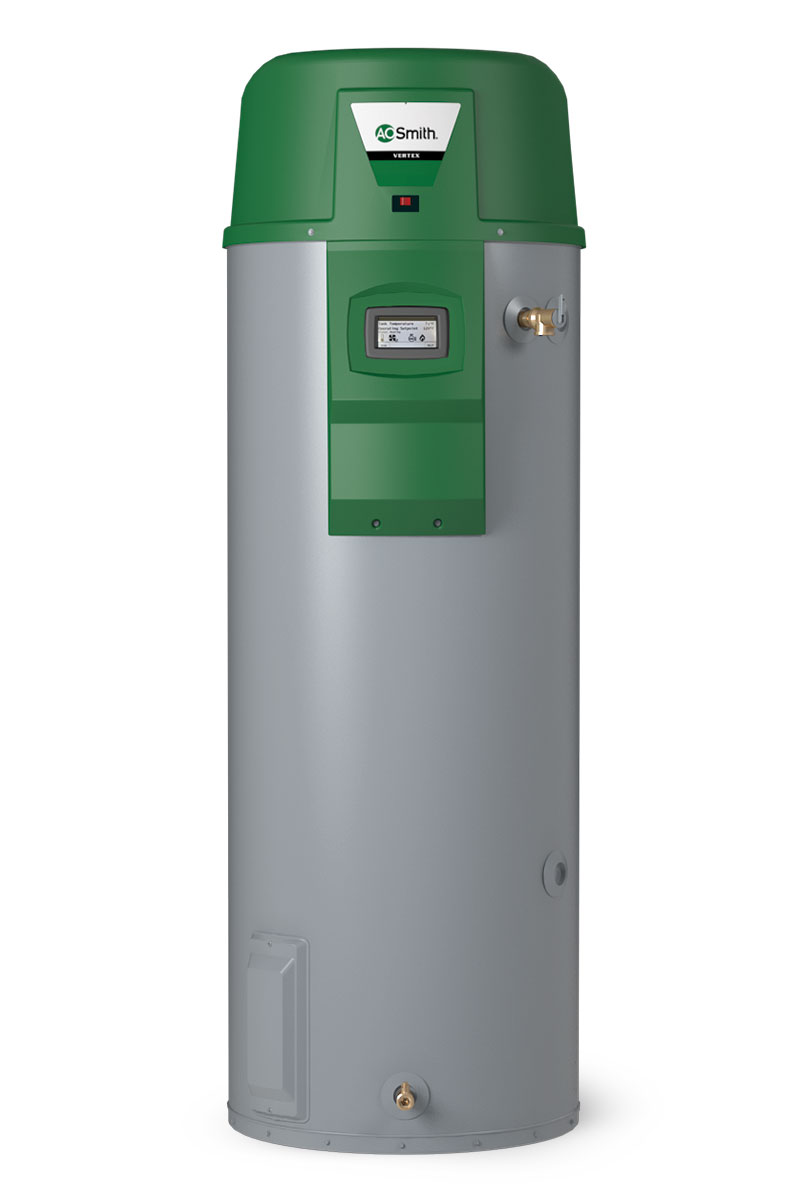 |
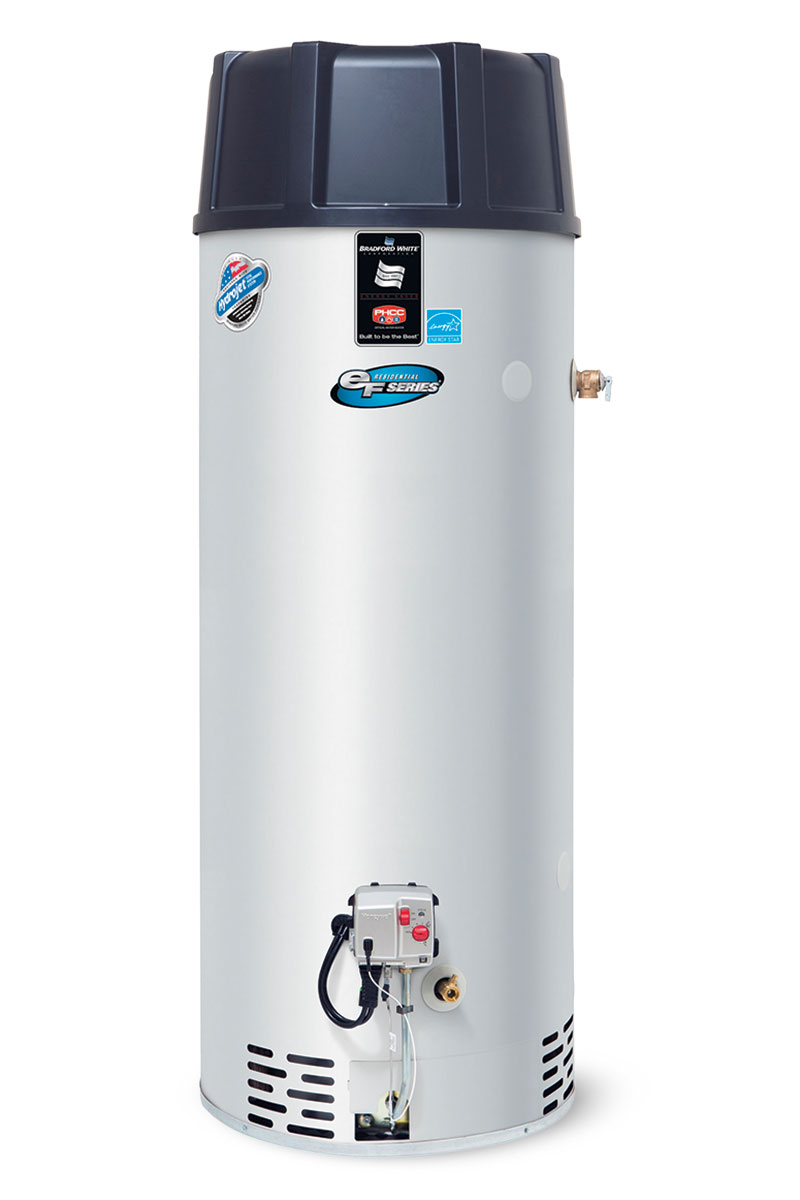 |
An upgrade from a standard gas water heater, condensing models pull residual heat from exhaust gases, increasing efficiency and decreasing flue-gas temperatures, the latter allowing for direct venting through plastic pipe. The trade-off is a higher price tag, which manufacturers argue is offset by utility savings over the life of the unit. They fall well below heat pumps in terms of efficiency, but also cost less and produce hot water more quickly than those units, and are typically 5% to 10% more thermally efficient than standard gas tank water heaters.
The best gas models are condensing
Although not the most efficient on the market, a tank-style water heater that burns natural gas is an economical way of providing domestic hot water in many markets. There are two basic choices in this category: standard and condensing. A conventional gas-fired water heater vents exhaust gases into a masonry or metal flue. A condensing unit includes an extra heat exchanger that pulls residual heat from the flue gases before they go out. Efficiency goes up, and the temperature of the exhaust goes down. The stack temperatures are low enough to allow the use of plastic pipe for the exhaust rather than a conventional chimney.
Keith Kuliga, assistant product manager at Bradford White Corp., says condensing gas water heaters are typically 5% to 10% more thermally efficient than noncondensing models.
Tankless (on-demand) water heaters also are available in both condensing and noncondensing models. Condensing models are more expensive but also more efficient. Rinnai lists the UEF for noncondensing models from 0.79 to 0.82; for condensing models the range is from 0.85 to a high of 0.93. They’re also more efficient than conventional tank-style gas units. The DOE’s directory of water heaters shows tankless gas appliances typically have UEFs in a range of 0.80 to 0.90 and up while tank-style water heaters show UEFs beginning in the 0.60 range.
Electric tankless heaters are another option, and they report very high UEFs, up to 0.98. But this thermal efficiency comes with some inconveniences—mainly a huge power draw. Rheem’s RTEX-24, for example, draws 100 amps at 240v and requires three 40-amp breakers. Given that some older houses still have 100-amp panels in the basement that run all appliances and plugs in the house, and the standard for a new home is 200 amps, that’s a lot of electricity. Critics also point to the intermittent but significant spikes in electrical demand as a problem for the grid.
What’s in the future?
At the moment, an electric heat-pump water heater holds a sizable lead in the efficiency department, although that comes with a higher initial cost. There are at least two, and probably more, emerging technologies that should help reduce the upfront costs of energy-efficient water heating.
One is a heat-pump water heater whose compressor is driven by gas, not electricity. The technology is at what the Northwest Energy Efficiency Alliance (NEEA) calls the “nascent stage,” under development for the residential market but not yet available commercially.
Aaron Winer, senior program manager for NEEA, said one manufacturer expects to have such a water heater on the market by 2022. Larger, commercial units are already available. The UEF of these appliances can hit the range of 1.2 to 1.4, a big step up from the most efficient gas-burning water heaters currently available but still far below the efficiencies of electric heat-pump water heaters.
“A big difference between these units is that the currently available technology costs in the range of $4000 for the unit and installation,” Winer said by email, “where a gas heat-pump water heater is projected to cost $3000 or less–all while delivering a significantly higher level of energy savings.”
The other area for improved efficiency is not in the equipment itself, but how it is used. “We see improved technologies and/or solutions based on a systems approach,” says Geoff Wickes, another senior program manager at NEEA. “Plumbing equipment; appliances that use less water; shorter, more appropriate plumbing runs; drain-water heat recovery; proper use of on-demand circulator pumps; and better insulation on pipes.”
Manufacturers also are adopting Wi-Fi technology. For households, the equipment allows greater control over when and how hot water is produced. For utilities, it means the potential for better managing loads on the grid and avoiding construction of new power plants. Rinnai, for example, now offers Wi-Fi features on a couple of its tankless heaters and says they can be paired with smart-home technology, such as Amazon’s Alexa devices, to allow homeowners precise control of a hotwater circulation system. A third-party device called the Aquanta is an add-on that allows water heaters to be controlled remotely.
Another demand on manufacturers is the increasing pressure to eliminate anything that burns any fuel—wood, oil, gas—and replace it with an appliance powered by electricity. Ideally, electricity derived from renewable sources. Even companies completely invested in gas technology, such as Rinnai, are keenly aware of the trend.
In the meantime, the question for heat-pump water heater manufacturers is how to get their market share out of the basement.
“There are many parts to this,” Miles said, “especially as at least 75% of the water heaters sold are for customers who need a unit on an emergency basis.”
Better consumer understanding of potential savings would help, as would government and utility rebates, and more decisive government directives on efficiency. And then there are the plumbers.
“The majority of plumbers hate new technology, especially when they can install a gas or electric water heater and not see it again for 5 to 10 years and then just replace it at that time,” Miles said. “The outcome from this is that they don’t want to install a new product they may have to service unless the homeowner really wants it and they are going to lose a sale.
“It has taken tankless products over 20 years to become about 20% of the 4.2 million gas water heaters sold annually,” Miles concluded.
More about water heaters
Top 10 Water-Heater Code Violations – Installing a tank water heater might seem easy, but some of these common mistakes could be life-threatening.
Tankless Water Heater Installation Quirks and Tips – Consider codes and appliance requirements when installing tankless natural gas and propane water heaters.
How to Install a Tankless Water Heater – Pluses include endless hot water and a compact design, but the installation means a lot of pipes in a small space.
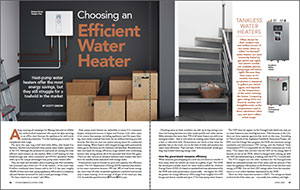
– Scott Gibson is a contributing writer at GreenBuildingAdvisor.com and Fine Homebuilding magazine.
Photos: courtesy of the manufacturers.
From FineHomebuilding #291
To view the entire article, please click the View PDF button below.

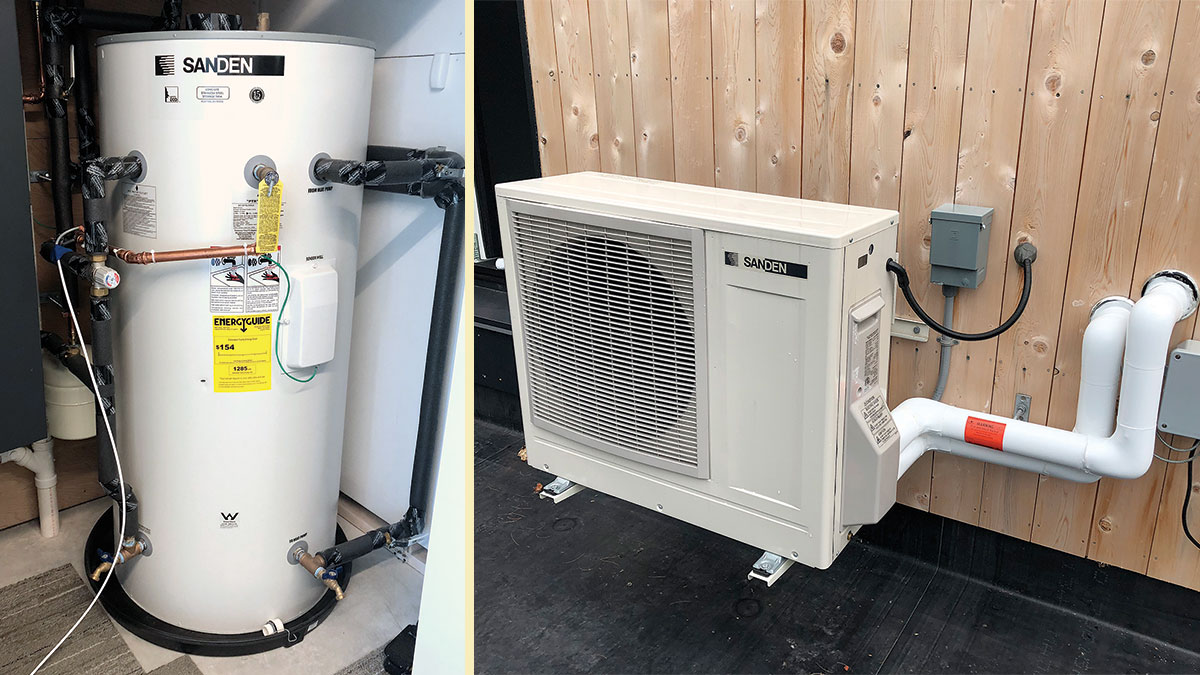





View Comments
I am weighing three tightly zoned electric on demand units vs a single heat pump unit. The up front costs are similar but how does it compare when you consider the additional piping necessary for moving heated water through a whole house? I can estimate it with formulas, but have no direct experience nor have I seen any scientific articles.